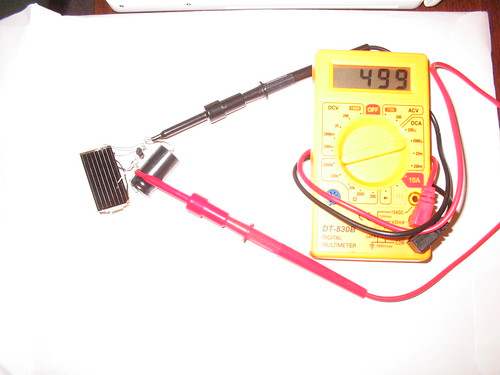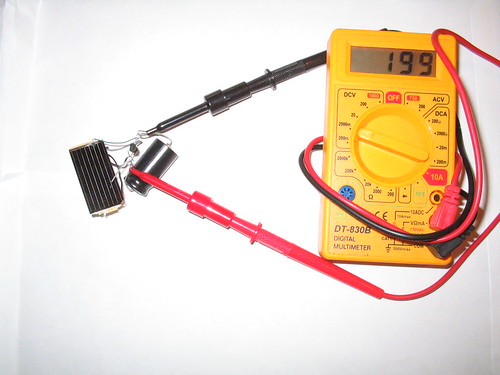Tuesday, March 31, 2009
Ups and Downs
Today has been an up and down day. I got a lot done at work, including a good bit of the new tension balance system that we're building. Then I found out that I was not accepted into the University of Pittsburgh grad program in electrical engineering. At the same time, my hopefully-future-advisor recommended another way to get in, and agreed to meet with me in Pittsburgh this coming Sunday when we go to see the Westinghouse "Atom Smasher" together (for more on this, AIAPBlog). Finally, I got some info on Hack Pittsburgh, which I think I'll be joining, along with dorkbot-pgh, when I move down there at the end of May.
Acquisitions
Things I really have to get for my workbench:
Tap and Die Set
Drill Press (at least 1/4" chuck)
Step Bit
Banana Clip Test Leads
BNC Breakout Box for my NIDAQ Card
BNC Male to Banana Female Adapter
MORE DRAWERS!
Magnifying Lamp
Scroll/Jigsaw
Anyone have any suggestions? Please put them in the comments!
Tap and Die Set
Drill Press (at least 1/4" chuck)
Step Bit
Banana Clip Test Leads
BNC Breakout Box for my NIDAQ Card
BNC Male to Banana Female Adapter
MORE DRAWERS!
Magnifying Lamp
Scroll/Jigsaw
Anyone have any suggestions? Please put them in the comments!
Sunday, March 29, 2009
Earth Hour
Last night, Katie and I turned off all the lights and read by LED tealights for Earth Hour. This morning I did some estimates on how everybody did last night: Google Docs Spreadsheet
I have to say that the estimates are quite rough, based on 2005 estimates for personal energy use, and on press coverage versus population in various regions. The final line is based on the worldwide per person estimate from 2005, and on the WWF's estimate of 1 billion people participating.
I'm glad to say that we apparently saved between 3 and 30 GWh. Yes, that's Giga-Watt hours.


I have to say that the estimates are quite rough, based on 2005 estimates for personal energy use, and on press coverage versus population in various regions. The final line is based on the worldwide per person estimate from 2005, and on the WWF's estimate of 1 billion people participating.
I'm glad to say that we apparently saved between 3 and 30 GWh. Yes, that's Giga-Watt hours.
Ideas on solarCharge v.1
First of all, thanks to Chris Connor for posting v.1 on the Make: Blog!
Now, some of the considerations I've come up with for v.2:
The lack of a good ferrite core may prove the undoing of this design. As it is, the ones that I have access to seem a bit large (over 1" long and .5" wide), and the more ferrite, the higher the flux density needed to achieve saturation, and therefore the higher the current needed to drive the dc-dc upconverter. This is also why I don't want to use a regular transformer. However, a small enough isolation transformer, like those used in VCRs, TVs, stereos, etc., might just do the trick.
Next time I'm building on a breadboard. Period.
The capacitor has to be limited to below 300 µF, since the upconverter runs at about 50 kHz. If you're wondering why this is, check out the concept of reactance.
Similarly, the original Joule Thief implementation of this upconverter ran a white LED. This means that they were using a half-wave rectifier on the circuit. If I manage to pump the voltage up to about 5.6 Vrms out (with a +2.8 V offset, meaning that the AC signal is all above the zero line), I'll be able to put a regular low-wattage diode in to trim some of the oscillations, and increase the size of the next capacitor downstream. However, I could make this an LED if I can get the design up to 6.7 Vrms.
Do I really need an LED in there, though? Somebody weigh in on this in the comments. I know that the higher the voltage (short of probably 8-9 Vrms) the better, so I'll build for this anyway, but it does seem to me that the LED might just be a waste of wattage, as might the rectifier itself.
Anyway, enough about v.2. I'd better get building.
Now, some of the considerations I've come up with for v.2:
The lack of a good ferrite core may prove the undoing of this design. As it is, the ones that I have access to seem a bit large (over 1" long and .5" wide), and the more ferrite, the higher the flux density needed to achieve saturation, and therefore the higher the current needed to drive the dc-dc upconverter. This is also why I don't want to use a regular transformer. However, a small enough isolation transformer, like those used in VCRs, TVs, stereos, etc., might just do the trick.
Next time I'm building on a breadboard. Period.
The capacitor has to be limited to below 300 µF, since the upconverter runs at about 50 kHz. If you're wondering why this is, check out the concept of reactance.
Similarly, the original Joule Thief implementation of this upconverter ran a white LED. This means that they were using a half-wave rectifier on the circuit. If I manage to pump the voltage up to about 5.6 Vrms out (with a +2.8 V offset, meaning that the AC signal is all above the zero line), I'll be able to put a regular low-wattage diode in to trim some of the oscillations, and increase the size of the next capacitor downstream. However, I could make this an LED if I can get the design up to 6.7 Vrms.
Do I really need an LED in there, though? Somebody weigh in on this in the comments. I know that the higher the voltage (short of probably 8-9 Vrms) the better, so I'll build for this anyway, but it does seem to me that the LED might just be a waste of wattage, as might the rectifier itself.
Anyway, enough about v.2. I'd better get building.
Saturday, March 28, 2009
solarCharge
After having seen this article on the Make:Blog, I said this:
I then went and built the solarCharge, v.1. This is essentially the Joule Thief with a small solar cell instead of a battery, and a large (50 V, 680 µF) capacitor across the Vout leads. I'm working with the materials that might be readily available to someone who's been able to scrounge through something like an old calculator junk pile, so I don't have a ferrite core, which is probably limiting me significantly. I think what I'll do for v.2 is build without limits to what the parts are, but with a minimum quantity of parts, and track the expense.


How about connecting a joule-thief circuit (DC-DC upconverter) to a cap on one side and a small solar cell (like the ones in calculators) on the other? You pull off of the cap to the cell phone directly. If I remember correctly, most cell phones have internal Vregs between the battery and the rest of the circuitry, so that takes care of your OV protection. I'll see if I can build this, and then get back to you.
I then went and built the solarCharge, v.1. This is essentially the Joule Thief with a small solar cell instead of a battery, and a large (50 V, 680 µF) capacitor across the Vout leads. I'm working with the materials that might be readily available to someone who's been able to scrounge through something like an old calculator junk pile, so I don't have a ferrite core, which is probably limiting me significantly. I think what I'll do for v.2 is build without limits to what the parts are, but with a minimum quantity of parts, and track the expense.


Sunday, March 22, 2009
Skills
I figured I eventually had to make this list. This is a list of fabrication skills that I have, and those that I want to learn.
Fluent:
Electronic design (Discrete Components)
Basic mechanical design
Scrounging for parts
Soldering (Electronics)
Conversant:
Blacksmithing
Board design
Milling/Drill press (Metal/Plastic)
Larger-scale carpentry
Rigging
Pipe soldering
Know how to order dinner:
Turning (Metal/Plastic)
MIG/TIG Welding
Sewing
Interested, and got my hands on:
Glass blowing/bending
Sheet metal work
Precision machining
PCB etching
Woodworking
Interested, and never got to try:
Composite work (i.e. fiberglass or carbon fiber)
Wood lathe
Knitting
If you or anyone you know can teach me any of the above, or at least more than I already know, please let me know!
Fluent:
Electronic design (Discrete Components)
Basic mechanical design
Scrounging for parts
Soldering (Electronics)
Conversant:
Blacksmithing
Board design
Milling/Drill press (Metal/Plastic)
Larger-scale carpentry
Rigging
Pipe soldering
Know how to order dinner:
Turning (Metal/Plastic)
MIG/TIG Welding
Sewing
Interested, and got my hands on:
Glass blowing/bending
Sheet metal work
Precision machining
PCB etching
Woodworking
Interested, and never got to try:
Composite work (i.e. fiberglass or carbon fiber)
Wood lathe
Knitting
If you or anyone you know can teach me any of the above, or at least more than I already know, please let me know!
Monday, March 16, 2009
Etsyness
I'm now on etsy with a little electronics parts store. As I wrote on the Genteel Recessionista's comments:
Modular income spot number 1268: Electronics components.
Think about this for a moment: an old CRT is somewhere between $50 and $free these days. These used to be $200-400. The number of components inside is between 500-1500, and these are discrete components due to the high powers in a CRT. This means that you’re getting components that were originally 14¢ each on average for a maximum of ¢10. Electronic components one-off go for somewhere north of $1 a pop, even for the smallest diode. Notice where the profit comes in? Check out my etsy store to see this in practice.
Subscribe to:
Posts (Atom)
